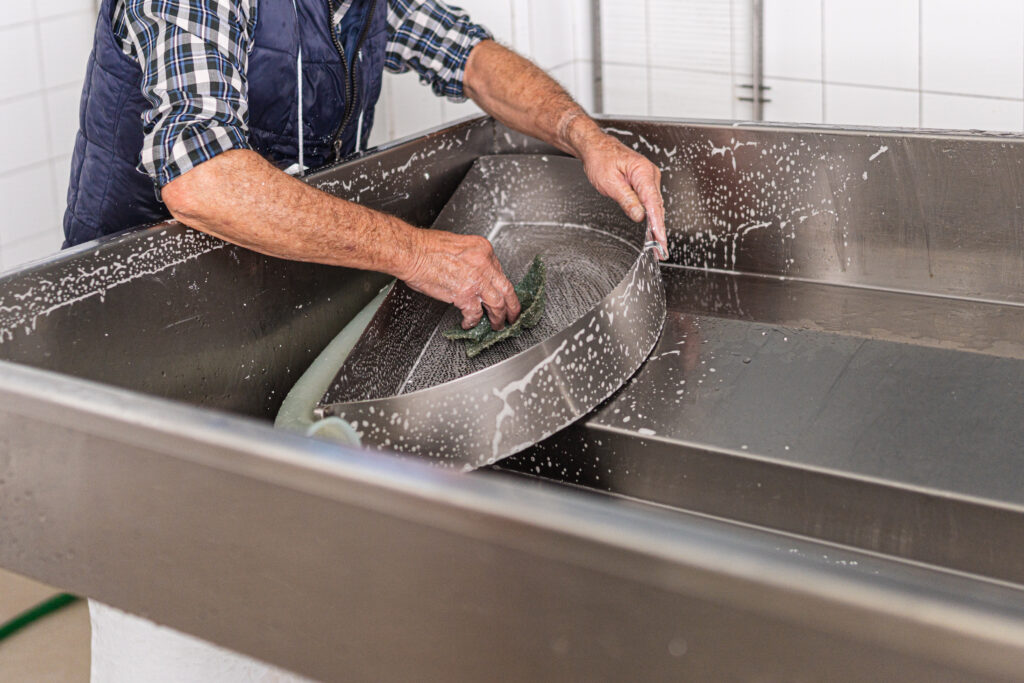In the past five years, the food processing industry has faced hard challenges like worker retention, labor shortages, and supply chain disruptions. For these issues and more, the answer increasingly seems to be: automation.
This is also true for the increasingly strict standard of hygiene placed on the industry. Automated washers are more sanitary, more economical, and more efficient than handwashing. But still, much of the industry is falling behind the curve, leaning instead on good old-fashioned handwashing.
What’s the difference between manual and automated washing?
Manual washing is when manufacturing personnel clean process items and surfaces by hand using hoses, sinks, and wash basins. This was the standard in food manufacturing for decades, until machinery advancements led to the rise of automated washers.
Automated washers are high-volume machines that clean and sanitize process items through a combination of heat, water jets, and chemicals. These machines come in many shapes and sizes, often tailored to a specific item type and volume.
Is automated washing always better than handwashing?
Many operations still lean on handwashing because they’re hesitant about the up-front cost of capital equipment, or they’re washing small or oddly shaped parts that are difficult for a machine to fully sanitize.
Automated washing is attainable for all operations and applications. There are washers, like the Douglas COP parts washer, designed specifically for small and obscure parts. Many washer manufacturers offer financing options, and the machines add tenfold value to the operation with benefits like:
- Improved Sanitation & Food Safety Compliance
- Quicker turnaround time for container re-use
- Increased Sustainability
- Increased Labor Efficiency
Improved Sanitation & Food Safety Compliance
Cleaning and sanitizing are different. Cleaning is the elimination of the visible and invisible soils. Sanitation is the act of reducing microorganisms to safe levels on clean equipment. You can’t sanitize a surface that is not already well-cleaned.
As with all people-led tasks, handwashing leaves room for human error. This may result in unclean items that must be tagged for rewashing, or unsanitary items that are returned to the processing line and pose a food safety hazard.
The post-pandemic population has a higher standard of food safety for products they’re willing to purchase. A Rutgers University study showed that many consumers will avoid purchasing food from a manufacturer that’s had a recall, even if it’s a different product.
As such, clear compliance with FDA and USDA guidelines is a must, but keeping consistent track of microbiome levels can be a hassle.
An automated washer cleans perfectly the first time, so you don’t have to worry about extended downtime or test every item before returning them to the processing line.
Quicker turnaround time for container re-use
Washers take a fraction of the time of handwashing to completely sanitize soiled containers. An automated pan washer can clean 432 bakery sheet pans an hour. A human worker would have to fully clean and sanitize every pan in eight seconds, taking no breaks, to match that volume and quality.
Automated washing can match the speed of your production, so you’re never slowed down waiting for items to be washed.
Uncareful or unskilled handwashing can also damage expensive processing items, especially over time. Automated washers are designed to be tough on grime but gentle on parts, fully cleaning without damage. This extends the life of your processing items and minimizes costly repairs or replacement.
Increased Sustainability
Over 40% of U.S. consumers surveyed in 2022 were willing to pay more for sustainable grocery products. So, minimizing resources used in manufacturing is a competitive advantage that also saves your bottom line.
Automated washers are built to high efficiency and sustainability standards. Water-recirculating tanks conserve water and caustic chemicals, while high-efficiency wash pumps use minimal electricity. This saves your dollar and the environment by conserving critical resources. For high-consumption industries like meat, where it currently takes 1,857 gallons of water to produce one pound of ground beef, high-efficiency practices can make a huge difference in time and money saved.
These machines can also track their washing history, producing accurate reports of resources like water, energy, and chemicals used so you know exactly what washing costs. It also allows you to ensure you’re complying with high standards of resource usage that set your operation apart.
Increased labor efficiency
Food manufacturers have struggled with labor shortages in recent years. There are currently over 750,000 unfilled manufacturing jobs, according to the U.S. Bureau of Labor Statistics, though unemployment is at an all-time low.
Automated washers wash hundreds of items an hour at the push of a button, minimizing the need for human intervention, so your workers can spend time on other value-adding tasks.
This also decreases occupational hazards like excess water and exposure to chemicals, foodborne pathogens, or machinery that could results in burns, slipping, allergic reactions, or injuries like cuts and bruises.


